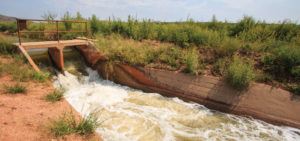
Imagine the state of Oklahoma with more water than it can use. All lakes and reservoirs across the state are full. Underground aquifers are replenished.
The farmer never worries about drought-ravished crops. The city manager never frets about supplying water for city residents. People from near and far travel to Oklahoma to recreate on the state’s plentiful lakes and rivers.
Oklahoma’s agriculture industry flourishes. The oil and gas industry booms. Tourism thrives. The Oklahoma economy prospers. Seem like a dream? It’s actually not far from reality.
As Oklahoma’s most precious commodity, water is the lifeblood of everything.
Yet, over the past decade, Oklahoma allowed an average of nearly 35.4 million acre feet of water to leave the state each year, according to U.S. Geological Survey data. That’s nearly 20 times the amount of water the entire state uses in a year. Developing Oklahoma’s water infrastructure and utilizing the state’s most precious resource can provide billions of dollars to the Oklahoma economy.
Why doesn’t Oklahoma work to develop water infrastructure across the state to ensure no Oklahoman ever wants for water? With an extra 35 million acre feet of water available every year, the state can fill every lake and reservoir, replenish every aquifer, and ensure every Oklahoman has access to an abundant source of water.
Though some may argue developing Oklahoma water is too big of a feat, cities around the state have developed water for decades.
The city of Enid currently is working to construct a pipeline from Kaw Lake to supply itself with water for the next 50 years. Oklahoma City pumps water more than 100 miles from Lake Atoka. Tulsa pumps water from Lake Eucha, Lake Spavinaw and Oologah Lake.
The technology exists; the idea is not difficult. What is difficult? Finding leaders with the vision and the courage to pursue it.
Why don’t Oklahomans demand more from their state elected officials? By the year 2060, Oklahoma water infrastructure will face an estimated $82 billion in improvements and replacements, according to the Oklahoma Comprehensive Water Plan. State leaders, including the Oklahoma Farm Bureau, must begin working today to secure a vibrant future for the state through a plentiful water supply. Will you join us?
